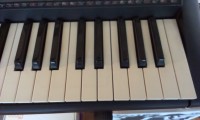Very simple electronic organ for children

This simple electronic instrument contains a small number of standard parts and needs no on/off switch.
This simple musical instrument was build for my children a couple of years ago. It is very simple and contains only standard parts. And -very important with children- an on/off switch is not needed. Nevertheless the batteries in my organ lasted more than five years.
Circuit description
The circuit contains a simple oscillator around IC1a, buffered by IC1d and a one transistor amplifier Q1. The volume is determined by the value of R11. The oscillator is single-tone; only the highest tone played is generated.
The tuning is not perfect, because I have used standard resistor (E96 series; I didn't want to use potmeters) and also depends on the battery voltage and temperature. By changing C1 the general tuning can be adapted to your personal wish.
By the way: 2 batteries (3 volts) will do as well and therefore also a single lithiun cell can be used if the device has to be very small. I build the organ into a left over alarmclock housing. There is no PCB layout available.
The instrument as I build it has 8 keys for the basic tones (white keys) of one octave. The other tones (black keys) can be added by splitting R2, R3, R4, R6 and R7. Also more tones can be added by inserting resistors and keys between R7 and R8. For my children one octave was enough.
Circuit description
The circuit contains a simple oscillator around IC1a, buffered by IC1d and a one transistor amplifier Q1. The volume is determined by the value of R11. The oscillator is single-tone; only the highest tone played is generated.
The tuning is not perfect, because I have used standard resistor (E96 series; I didn't want to use potmeters) and also depends on the battery voltage and temperature. By changing C1 the general tuning can be adapted to your personal wish.
By the way: 2 batteries (3 volts) will do as well and therefore also a single lithiun cell can be used if the device has to be very small. I build the organ into a left over alarmclock housing. There is no PCB layout available.
The instrument as I build it has 8 keys for the basic tones (white keys) of one octave. The other tones (black keys) can be added by splitting R2, R3, R4, R6 and R7. Also more tones can be added by inserting resistors and keys between R7 and R8. For my children one octave was enough.



Discussion (3 commentaire(s))